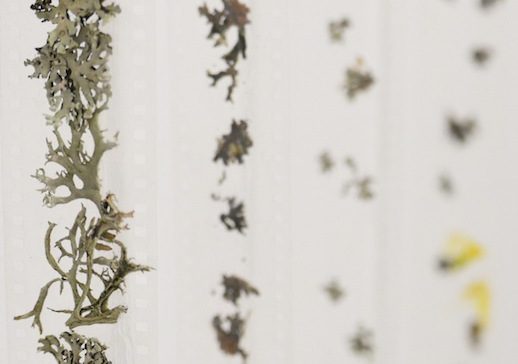 Lichen photograms. Image: Rob St John
Lichen photograms. Image: Rob St John
Back in February, we ran a piece by Rob St John entitled ‘Emergent Landscapes’, which focused on the topography he saw in images he had made with a defective Polaroid camera. Rob’s new installation – which shares the piece’s title and ideology, and will be accompanied by a series of workshops – opens at the Tate Modern next month. He introduces it below:
Emergent Landscapes is a participatory installation at Switch House, Tate Modern, running between 9-11 December as part of Tate Exchange, which is both a programme and space for the public of all ages and interests to collaborate, test ideas and discover new perspectives on life, through art. Emergent Landscapes involves two shared, public elements – cairn construction and the layering of a soundscape which echoes visitor movements, reflections and perceptions in and around the the space – and a number of new film and text pieces created for the project.
I’m interested in the role of cairns as collective, collaborative and emergent landscape sculptures – as markers, beacons, memorials, topping out points – often of anonymous or uncertain heritage. Most people I know can’t resist adding a stone to a cairn on a pathway or hilltop as they pass by – there’s something very satisfying about adding to the accumulation of previous stone-y gestures and interventions. Filming for the project recently on Winter Hill on Rivington Moor in Lancashire, I was struck by the visual similarities between a bronze age burial cairn and pile of recent building rubble (from the television masts) close-by on the open moortop; a real tension of form and function, age and origin. Cairns are means of marking time and space; aggregates that can be at once allusive and elusive.
I’ll work with visitors over the installation period to build a cairn to mark the newly built gallery space in Switch House, layered with strata of slowly activating lichen and moss paints: marks and actions overlaid in the construction. The cairn will be constructed of clay tiles (riffing on the bedrock underneath Tate, and the tones of the brickwork in Switch House), wooden shingles (cut from a woodland in Dorset where the cairn will subsequently be installed), and a small number of plastic tiles (a prompt for thinking about the strange new geological strata of the Anthropocene).
An old gramophone horn will be re-purposed as a sound-gathering device, through which visitors will be able to ‘lend their voice’ to a layered soundscape consisting of voices and field recordings taken in and around Tate. Earlier voices will be heard as traces, affected through the convolution reverbs of various spaces in the building (the Turbine Hall, the Tanks), so in effect, each new contribution will be part of an ongoing conversation with the flows of both people and place.
When the installation period is done, the new soundscape will be dubbed onto 1/4 inch reel to reel tape, and the spool buried within the completed cairn. The whole structure will then be transported to Hooke Park woodland in Dorset, where in collaboration with the Architectural Association and Common Ground charity, it will be freely accessible and documented for years to come.
It is intended that over months and years, the spores and seeds ‘painted’ onto the cairn materials will germinate and grow; to emerge, develop and even destroy the structures created in the gallery. In this way, there is no way of knowing whether any gallery participant’s tile painting will result in ecological growth and patterning, but it is likely that many will. Indeed, it is likely that the structure will provide new habitat niches for vegetation, insects and small mammals in the woodland.
As such, what is initially blank or obscured has the potential to erupt into life and colour in the cairn’s development: an ecology of chance born in the city and bloomed in the country. It is intended that in the future, the cairn may buckle or collapse to reveal the tape spool, which will have undergone years, if not decades, of organic decay and development. Like the cairn, this recorded soundscape will be an inherently altered and emergent document of the activity at Tate Exchange in Emergent Landscapes.
*
Emergent Landscapes is on between 9-11 December at the Tate Exchange, Switch House, Tate Modern, Bankside, London SE1 9TG. More details can be found on the Tate website.